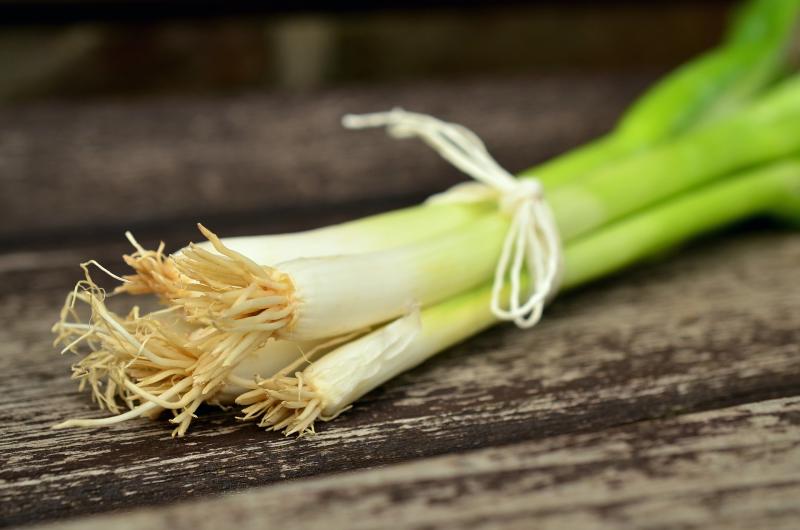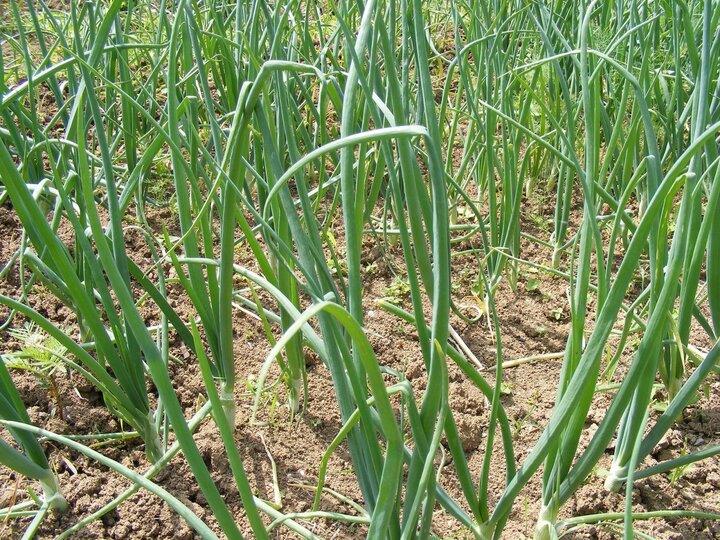Sarah Browning, Nebraska Extension Educator

Green spring onions; image by Pixabay.com.
Planting onions from small bulbs or "sets" is not the best way to grow large onions for storage. Plants grown from sets often begin blooming in mid-summer and stubbornly refuse to stop. Once that happens, onion bulbs don't increase much in size.
Onion Sets
This happens because onions are biennials. They grow foliage and a bulb the first season, then bloom and set seed in their second growing season. Growing the sets counts as one growing season - although it is definitely a short one! But it leaves the sets primed to begin reproducing by setting flowers after you plant them in the garden. This makes onion sets a great way to grow green onions, but not the best way to grow onions for long term storage.
Because of onion's biennial nature, plants grown from seed or transplants don't bloom the first year and so have more growing time to develop larger bulbs. Many mail-order companies and garden centers now carry onion transplants in spring, but you can also grow your own.
Growing Onion Transplants
Onion transplants can be grown in approximately 10-12 weeks. Sow seeds in late February or early March for planting outdoors in early May. Plant seeds ¾ inches deep in a seed-starting soil blend and keep them evenly moist. Once they sprout, provide the seedlings with bright light from a sunny, south-facing window, or better yet, provide supplemental light with fluorescent fixtures placed a few inches above them for 12-14 hours each day.
Transplant the little, grass-like seedlings outdoors as soon as garden soil is dry enough to work thoroughly and daytime temperatures reach 50° F. Onion transplants will tolerate light frosts. Planting as early as possible is important because more leaf growth equals bigger bulbs. Each leaf will develop one layer in the onion bulb and the more layers, the bigger the bulb at harvest.
Place the seedlings 4 inches apart in wide row plantings. When using “wide” rows plants are not placed single file on one long row, but spaced through a row ranging from 6 to 36 inches across. Use a row width that is convenient for you to reach fro both sides, to make harvesting and weed control easier.
Direct Seeding
Onions can also be direct seeded. This is a good option if you can’t find your favorite cultivar as a transplant. Plant seeds as soon as the soil can be worked, usually from mid to late March. Wide row spacing also works well when planting onion seeds. Plant the seeds 1/4 - 1/2 inch deep in the soil. Space rows 12-18 inches apart. Once the plants have 5-10 leaves, they can be thinned so the remaining plants are spaced 3-4 inches apart, and the harvested plants used as green onions.

Growing On
Onions grow best in well-drained soil, 6.5 pH, with a high level of organic matter. Raised beds, 4-6 inches high, work well to provide good soil drainage if the native soil is heavy. They also need plenty of sunlight, and regular watering. The installation of drip irrigation the length of the rows makes watering easier and more uniform. Don’t be concerned if a large portion of the bulb develops above ground; that's normal for onions.
Images from Pixabay.com.
- Green onions
- White onion sets
- Onions growing in the garden
Search Our Archive
Associated Video
Planting Onions
Nebraska Extension Educator Sarah Browning demonstrates how to choose onions and how to plant them.<br />
<br />